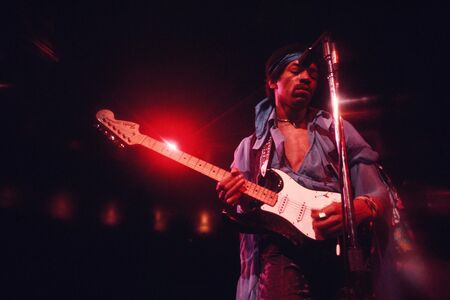Don't Give Up on the Guitar. Fender Is Begging You
Every quitter hurts.
Each holiday season, thousands of teenagers tear gift wrap off shiny, new guitars. They giddily pluck at the detuned strings, thinking how cool they'll be once they're rock stars—even if almost all will give up before they ever get to jam out to "Sweet Child o' Mine."
For them, it's no big deal to relegate the guitar to the back of the closet forever, in favor of the Playstation controller. But it is a big deal for Fender Musical Instruments Corp., the 70-year-old maker of rock 'n' roll's most iconic electric guitars. Every quitter hurts.
"The industry's challenge—or opportunity—is getting people to commit for life," said Andy Mooney, Fender's chief executive officer. "A pretty big milestone for someone adopting any form of instrument is getting them through the first song."
The $6 billion U.S. retail market for musical instruments has been stagnant for five years, according to data compiled by research firm IBISWorld, and would-be guitar buyers have more to distract them than ever. So how do you convince someone to put down the iPhone, pick up a Stratocaster, and keep playing?
Beginning players, whether they're fickle teens or too-busy adults, have always quit the guitar at high rates. Guitar makers have never before made much of a concerted effort to keep them, Mooney said. But Fender estimates that nearly half its customers are first-time players, and it's making an effort to treat them as such.
Fender says it hauls in about a half-billion dollars a year in revenue and is on track to grow in the high single digits this year. That's still down from its $700 million in revenue in 2011, a number revealed when the company filed for an initial public offering in 2012 that was later withdrawn.
The task of keeping kids hooked on playing is a tricky one for a company still crawling back from post-recession struggles. In late 2012, as Fender fought to stay profitable, private equity firms TPG Growth and Servco Pacific took control of it. Last year, they brought on Mooney, a veteran executive who held posts at Disney, Nike, and Quiksilver, to make Fender more digital- and consumer-focused.
That means more apps, more connected devices, and a newfound focus on helping folks learn how to play their guitars. The hope is that players will get hooked early on cheap starter models, then upgrade to fancier guitars as they commit themselves to playing, with the most devoted among them evolving into collectors, their walls hung with high-end instruments. That all means more cash for Fender.
Almost everyone who picks up a guitar, about 90 percent, abandons it within the first year, according to Mooney. Many give up within three months, frustrated or unwilling to commit. Some people bounce to another instrument. And people quit electric guitars more often than acoustic ones, he said, because of the pain factor: Steel strings hurt delicate hands.
Over the next few years, the company will be releasing a suite of digital products to help keep new guitar players strumming along.

Jimi Hendrix performs at the Felt Forum on Jan. 28, 1970, in New York.
Photographer: Walter Iooss Jr./Getty Images
The first, a tuning app, teaches players how to change the pitch on their guitars, whereas most of the dozens of existing tuning apps assume some level of guitar proficiency. "When the kid plugs it in for the first time, it doesn't sound like a screaming cat when it comes out of an amp," said Mooney. "We want to help with a lot of the basic stuff."
Fender is also looking to release a practice-room app that can teach someone to play any song in their music library, along with a tone app that lets an amp emulate the sounds of famous guitarists. Fender's newest amp model, to be released next year, will be able to connect to apps wirelessly, through Bluetooth, to let players alter and share sound effects.
Fender says about 60 percent of its business is in guitars, both electric and acoustic; the rest is a mix of related products such as amps and picks. (The company acquired Aurisonics, a maker of medical and military-grade in-ear monitors, in January and announced new lines of the headphones.)
When it comes to selling guitars,
Nearly all Fender's business is done through traditional retailers; online sales from its own website make up less than 2 percent of total sales in North America. Mooney doesn't see that as a problem. Players need to touch, feel, and play a guitar before they buy one, he said, and his company prefers to use the internet as a learning tool for shoppers, rather than to drive sales.
Detractors have predicted the death of the electric guitar for years, pointing to the rise of rap and electronic dance music on pop charts.
But Mooney isn't worried. More women are playing guitar these days, he said—something he credits largely to Taylor Swift—and Fender now sees as many women as men playing the acoustic guitar, if not the electric. And although the mix of instruments sold is constantly shifting, guitar sales have actually grown over the past decade, he said. "The pendulum swings back and forth." (http://www.bloomberg.com/news/articles)
No comments:
Post a Comment